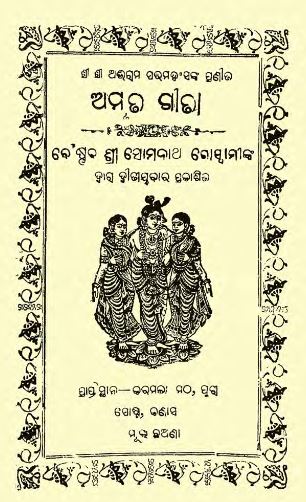In the realm of Odia literature, few works resonate as deeply and profoundly as “Amrut Gita,” a notable poetry collection penned by Abhiram Paramhans and published in 1941. This remarkable work is not merely a collection of verses; it serves as a spiritual guide, a philosophical reflection, and an artistic masterpiece that transcends time and continues to inspire generations.
Abhiram Paramhans, often acknowledged for his profound understanding of spirituality and life, infuses “Amrut Gita” with his intrinsic vision. The title itself, which translates to “The Nectarous Song,” signifies the essence of the work—poetry that nourishes the soul and provides solace in moments of despair. Written against the backdrop of a tumultuous era, marked by socio-political upheavals, the poems within “Amrut Gita” resonate with the quest for inner peace and wisdom.
One of the most distinguishing features of this collection is its lyrical quality. Each poem flows with an ethereal beauty, reflecting Paramhans’s mastery of language and form. He skillfully weaves traditional Odia motifs with universal themes, such as love, devotion, the divine, and the complexities of human existence. The musicality of his verses captures the reader’s imagination, drawing them into a world where the sacred and the secular intertwine.
Among the various themes explored in “Amrut Gita,” the concept of Stuti, or praise, holds a central place. Paramhans’s artful expression of devotion is evident in his odes to the divine, where he pours forth admiration and love for the Almighty. These stanzas transcend mere worship; they evoke a sense of personal connection with the divine, creating an intimate dialogue between the poet and God. Such verses invite readers to reflect on their own spiritual journeys, presenting the divine as both a distant figure and an ever-present companion.
The depth of feeling in “Amrut Gita” is also marked by its philosophical underpinnings. Paramhans explores the nature of existence, urging readers to seek truth beyond the superficial. His reflections on life, suffering, and the pursuit of knowledge prompt a contemplative response, encouraging individuals to delve deeper into their own experiences. This blend of spirituality and philosophy makes “Amrut Gita” not just a literary work, but a spiritual manual for seekers of all ages.
Furthermore, the cultural significance of “Amrut Gita” lies in its role as a bridge connecting traditional Odia literature with modern expressions of thought. At a time when the Odia language was gaining prominence, Paramhans’s work showcased its potential to articulate complex ideas and emotions. His poetry celebrates the richness of Odia heritage while making it accessible to contemporary readers.
In conclusion, “Amrut Gita” by Abhiram Paramhans is a testament to the enduring power of poetry as a vehicle for spiritual awakening and philosophical inquiry. Its message of devotion, introspection, and the search for truth remains as relevant today as it was in 1941. For those exploring the depths of Odia literature, this collection is indispensable—a source of inspiration, reflection, and, ultimately, a celebration of the human experience. As we immerse ourselves in its verses, “Amrut Gita” invites us to embark on our own journeys toward enlightenment, one poetic line at a time.
Books Info
| Books name | Amrut Gita/ଅମୃତ ଗୀତା |
| Editor | Abhiram Paramhans |
| No Of pages | 199 |
| Publisher | Sri Somanatha Goswami |
| Publication | 1941, 2e. |
| Printed At | NA |
| Distributor | NA |

